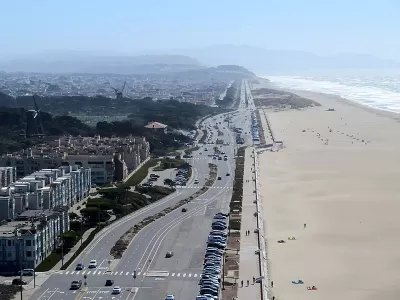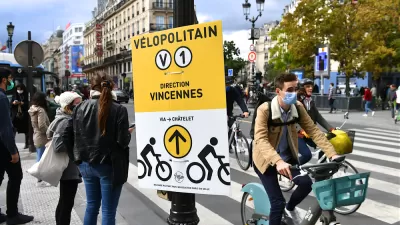Although the project has been hugely successful with local residents, the mayor and some county supervisors wanted to revert the road to vehicle use.

The "Great Walkway," a "pedestrian paradise" created in San Francisco during the pandemic, reopened to cars on August 16. An article written by Heather Knight describes the former 17-acre park, converted to a car-free promenade in April 2020, as "one of the few silver linings to emerge from the COVID-19 pandemic." Since then, "[a] city study found it was incredibly popular — drawing 126,000 visitors each month, including 3,240 each weekday," and 53% of respondents to a survey wanted the change to remain permanent. "The city also rightly responded to neighbors’ concerns about increased traffic on their streets, installing stop signs, speed humps and traffic diverters" on adjacent roads.
Now, in a surprise move that angered mobility advocates, the city's mayor and three county supervisors have "privately decided" to reopen the Great Highway to cars five days a week, citing concerns about access to schools. But "[i]n a city that has 1,200 miles of roads for cars, devoting a small fraction to pedestrians and bicyclists isn’t too much to ask," argues Knight. "If giving 2 miles of the Great Highway to people two days a week is a compromise, as the mayor says, that’s a strange definition."
Before the reopening, close to 600 residents gathered to protest the reopening of the street. The San Francisco Bicycle Coalition said in a statement that the organization "continues to firmly believe that the Great Highway should be a park and be car-free 24/7." Meanwhile, "three city residents on Tuesday planned to file a California Environmental Quality Act appeal in an attempt to block the return of the roadway to vehicles," arguing that putting cars–along with their polluting emissions–back on the street merits an environmental review.
FULL STORY: Sadly, S.F. getting ready to reopen Great Highway - a pedestrian 'paradise' during pandemic

Planetizen Federal Action Tracker
A weekly monitor of how Trump’s orders and actions are impacting planners and planning in America.

San Francisco's School District Spent $105M To Build Affordable Housing for Teachers — And That's Just the Beginning
SFUSD joins a growing list of school districts using their land holdings to address housing affordability challenges faced by their own employees.

The Tiny, Adorable $7,000 Car Turning Japan Onto EVs
The single seat Mibot charges from a regular plug as quickly as an iPad, and is about half the price of an average EV.

Seattle's Plan for Adopting Driverless Cars
Equity, safety, accessibility and affordability are front of mind as the city prepares for robotaxis and other autonomous vehicles.

As Trump Phases Out FEMA, Is It Time to Flee the Floodplains?
With less federal funding available for disaster relief efforts, the need to relocate at-risk communities is more urgent than ever.

With Protected Lanes, 460% More People Commute by Bike
For those needing more ammo, more data proving what we already knew is here.
Urban Design for Planners 1: Software Tools
This six-course series explores essential urban design concepts using open source software and equips planners with the tools they need to participate fully in the urban design process.
Planning for Universal Design
Learn the tools for implementing Universal Design in planning regulations.
Smith Gee Studio
City of Charlotte
City of Camden Redevelopment Agency
City of Astoria
Transportation Research & Education Center (TREC) at Portland State University
US High Speed Rail Association
City of Camden Redevelopment Agency
Municipality of Princeton (NJ)





























